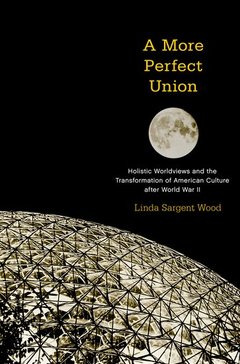A More Perfect Union Holistic Worldviews and the Transformation of American Culture after World War II
Langue : Anglais
Auteur : Wood Linda Sargent

In 1962, when the Cold War threatened to ignite in the Cuban Missile Crisis, when more nuclear test bombs were detonated than in any other year in history, Rachel Carson released her own bombshell, Silent Spring, to challenge society's use of pesticides. To counter the use of chemicals--and bombs--the naturalist articulated a holistic vision. She wrote about a "web of life" that connected humans to the world around them and argued that actions taken in one place had consequences elsewhere. Pesticides sprayed over croplands seep into ground water and move throughout the ecosystem, harming the environment. Thousands accepted her message, joined environmental groups, flocked to Earth Day celebrations, and lobbied for legislative regulation. Carson was not the only intellectual to offer holistic answers to society's problems. This book uncovers a holistic sensibility in post-World War II American culture that both tested the logic of the Cold War and fed some of the twentieth century's most powerful social movements, from civil rights to environmentalism to the counterculture. The study examines six important leaders and institutions that embraced and put into practice a holistic vision for a peaceful, healthful, and just world: nature writer Rachel Carson; structural engineer R. Buckminster Fuller; civil rights leader Martin Luther King Jr.; Jesuit priest and paleontologist Pierre Teilhard de Chardin; humanistic psychologist Abraham Maslow; and the Esalen Institute and its founders, Michael Murphy and Dick Price. Each looked to whole systems instead of parts and focused on connections, interdependencies, and integration to create a better world. In the 1960s and 1970s, holistic conceptions and practices infused the March on Washington, Earth Day, the human potential movement, New Age spirituality, and alternative medicine. Though dreams of creating a more perfect world were tempered by economic inequalities, political corruption, and deep social divisions, this sensibility influenced American culture in important ways that continue into the twenty-first century.
Preface. Introduction: Holistic Sensibilities in the Long 1960s. Chapter 1: The Natural Environment: Rachel Carson's Web of Life. Chapter 2: The Built Environment: Buckminster Fuller's Spaceship Earth. Chapter 3: The Social World: Martin Luther King, Jr.'s Beloved Community. Chapter 4: Cosmic Dimensions: Pierre Teilhard de Chardin's Omega Point. Chapter 5: The Psychological Realm: Abraham Maslow's Self-Actualized Individuals and Eupsychian Community. Chapter 6: The Esalen Institute: A Center for Holistic Pursuits. Epilogue. Notes. Bibliography. Index.
Linda Sargent Wood Assistant Professor of History, Arizona State University
Date de parution : 10-2012
Ouvrage de 352 p.
15.7x23.5 cm
Date de parution : 09-2010
Ouvrage de 352 p.
16.2x24.2 cm
© 2024 LAVOISIER S.A.S.



